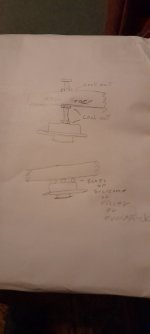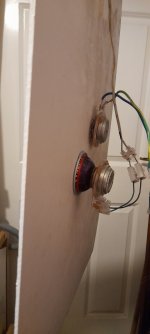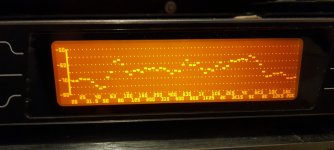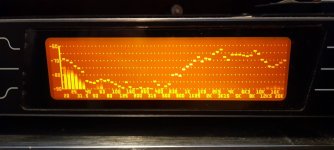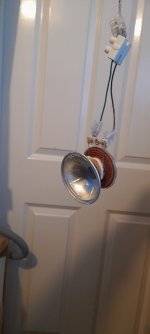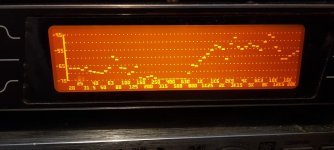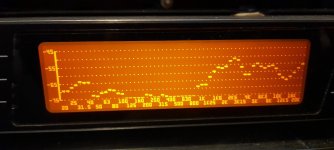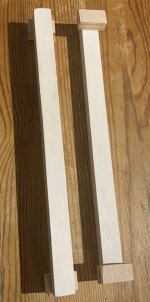I just ordered a pair of 3 mm baltic birch panels from: MakerStock.com (I have no affiliation with them) to try in my new Abstracta frames.
MakerStock will even cut to specific sizes.
Seems like reasonable prices.
MakerStock will even cut to specific sizes.
Seems like reasonable prices.
+ @pwayPaul,
I don't know Elmer, but LISA works pretty well for me. It can handle orthotropic materials, which is important to me since the most interesting panel materials (like plywood and other sandwich composites made with carbon fiber or fiberglass skins) are all orthotropic. As far as supports, LISA can do free, simple, clamped, and any combination thereof.
There's a free version of LISA which has a pretty limited number of nodes, but actually it's enough to do some reasonable plate models. I paid for the full version which I think was $100.
Eric
Hello Paul, hello Eric
For the materials, what about the most standard :
- EPS E 6MPa, density 18kg/m³
- XPS E 21MPa, density 31kg/m³
- poplar plywood E 9GPa, density 530kg/m³
For the dimensions why not Leob's choice 500x330mm (25mm thick), for plywood Burntcoil's tall blonde 1160x300mm, Eric 406x584mm or 305x1200mm.
Eric, are those figures ok for you?
Paul, those information are gathered in the history file. Follow the link "github.com" under my signature on the left of the post.
For the FEM tool, Elmer might be interesting as it is multi-plateform (my computer is under Linux Manjaro...), LISA doesn't work in the windows emulation. Some tutorial needed for me!
Christian
Sorry for my quick bad drawing.That is what I call dedication🙂 I slowly continue with the Ikea canvases, yesterday I glued 160 x 270 x 4mm poplar plywood panels to them. The back side of the panels was pre-coated with 50/50 PVA/water mixture just to provide some basic protection.
I have a question about mounting the daex30hesf-4 to the spine - can I use the M6 thread/screw with a neoprene or rubber washer between the exciter and spine? I would also put on some Loctite to the thread, so that it does not get loose.
The quickest and easiest way would be the silicone blobs.
Just leave a small gap in between the spine and the exciter, with the canvas on a flat surface.
Then just squirt the filler into the gap , when it's dry the exciter will be positioned perfectly.
You can use different fillers that dry harder if desired.
If you use the bolt method you could use nuts to lock the bolt into position without loctite .
This would also allow you to adjust the exciter position if necessary.
Steve.
Attachments
Eric, Christian
Thanks, I will post some results shortly.
I like the idea of FOSS and there are several mature alternatives I think. Salome with Code Aster/Code Saturne is very mature and I had used Salome for building models (the Salome builder interface is cleaner than FreeCad IMO). But the options for using the GUI for FEM looked complex/labyrinthine when I watched some tutorials.
I tried Elmer after seeing it was a 'multiphysics' solver with a simple approach to set up interfaces for multiphysics models.
I would like to explore not just the modes, but forced vibration, and also linking to Helmholtz equation in far field. As you know I think shape is paramount for a smoother spectrum, in particular I want to explore perimeter length, and the judicious placement of one or more holes to bring back those even mode shapes.
Elmer is a mixed bag, as are all of them I expect. It is used mainly in research I believe, and has a large variety advanced algorithms including electromagnetics (exciter design, anyone?). It has a set of tutorials and a forum. But I think in the end you need to understand the strengths and limitations of each algorithm by doing you own research. For example I am currently using the dedicated 2D elastic plate model, but I think the more general 3D elastic model will allow simulation of non-isotropic materials, presumably with much longer run-time.
It has a GUI interface, which BTW I have recently concluded is NOT worth the trouble in the end - easier and less error-prone to use the command line and plain-text simulation input file (.sif). There is a python interface which looks promising to streamline workflow, but I am going basic interface at the moment. There is a lot of documentation but it (and the examples) have not been kept up to date with changes in the meshing software, preprocessors etc. And I found questions on the forum which I wanted answers to with no response. But it does seem easy to use overall (once you get over initial hurdles and learning curve). And I believe the algorithms available are well tested. There are already some examples of computational acoustics with it here https://computational-acoustics.gitlab.io/website/tags/elmer/. So it looks like a reasonably solid choice to me.
I am using gmsh for meshing, Elmer for FEM and Paraview for viewing results, which I think is the most common route now, but a lot to take in.
Thanks, I will post some results shortly.
I like the idea of FOSS and there are several mature alternatives I think. Salome with Code Aster/Code Saturne is very mature and I had used Salome for building models (the Salome builder interface is cleaner than FreeCad IMO). But the options for using the GUI for FEM looked complex/labyrinthine when I watched some tutorials.
I tried Elmer after seeing it was a 'multiphysics' solver with a simple approach to set up interfaces for multiphysics models.
Elmer is a mixed bag, as are all of them I expect. It is used mainly in research I believe, and has a large variety advanced algorithms including electromagnetics (exciter design, anyone?). It has a set of tutorials and a forum. But I think in the end you need to understand the strengths and limitations of each algorithm by doing you own research. For example I am currently using the dedicated 2D elastic plate model, but I think the more general 3D elastic model will allow simulation of non-isotropic materials, presumably with much longer run-time.
It has a GUI interface, which BTW I have recently concluded is NOT worth the trouble in the end - easier and less error-prone to use the command line and plain-text simulation input file (.sif). There is a python interface which looks promising to streamline workflow, but I am going basic interface at the moment. There is a lot of documentation but it (and the examples) have not been kept up to date with changes in the meshing software, preprocessors etc. And I found questions on the forum which I wanted answers to with no response. But it does seem easy to use overall (once you get over initial hurdles and learning curve). And I believe the algorithms available are well tested. There are already some examples of computational acoustics with it here https://computational-acoustics.gitlab.io/website/tags/elmer/. So it looks like a reasonably solid choice to me.
I am using gmsh for meshing, Elmer for FEM and Paraview for viewing results, which I think is the most common route now, but a lot to take in.
Last edited:
Here are some results for XPS rectangular panel
Resonant frequencies (hand-calculated from eigenvalues printed to stdout during the run, as I have yet to look at calculated output 🙂)
80.8, 104, 147, 206, 208
- Clamped support all sides
- 1200x600x30
- Density 30 kg/m^2
- Poisson 0.35
- Youngs modulus 20 MPa
Resonant frequencies (hand-calculated from eigenvalues printed to stdout during the run, as I have yet to look at calculated output 🙂)
80.8, 104, 147, 206, 208
Run 2 "How low can we go?"
As above but cantilevered: clamped on short edge, free on all others:
Mode shapes look plausible.
2.8, 11.8, 17.6, 38.6, 49.4
As above but cantilevered: clamped on short edge, free on all others:
Mode shapes look plausible.
2.8, 11.8, 17.6, 38.6, 49.4
Run 3: Simple support all sides (if my assumptions are correct about the Elmer BCs )
Shift is in the right direction compared with clamped.
40.8, 64.9, 105, 121, 162
There are a few other BCs available including 'soft simple support', which sounds like it might be useful, but IDK how to specify.
Shift is in the right direction compared with clamped.
40.8, 64.9, 105, 121, 162
There are a few other BCs available including 'soft simple support', which sounds like it might be useful, but IDK how to specify.
I have done a few crazy things with this whizzer idea, but here is 2.
Pic1
I glued the exciter to the whizzer then bluetacked the whizzer to the back of the panel.
Pic2
Is the measurement at 1m.
Pic3
Is the whizzer measurement at 3m ,the XO was at 770hz to match my TLs(not shown) , only with small blob of bluetack holding it on to wooden insert glued to the coil foot , this sounded best to me, so far?
Pic4
Is the whizzer.
Pic5.
Is the response at 1ft peaks that need fixing showing.
Pic6
The whizzer 1ft from the side , peaks reduced , still with good output from the side.
The main problem is matching it to a panel that needs it and is at the same volume level as the panel.
To be continued.
Steve.
Pic1
I glued the exciter to the whizzer then bluetacked the whizzer to the back of the panel.
Pic2
Is the measurement at 1m.
Pic3
Is the whizzer measurement at 3m ,the XO was at 770hz to match my TLs(not shown) , only with small blob of bluetack holding it on to wooden insert glued to the coil foot , this sounded best to me, so far?
Pic4
Is the whizzer.
Pic5.
Is the response at 1ft peaks that need fixing showing.
Pic6
The whizzer 1ft from the side , peaks reduced , still with good output from the side.
The main problem is matching it to a panel that needs it and is at the same volume level as the panel.
To be continued.
Steve.
Attachments
This shaker looks very similar to the aer bbx driver without the cone.
Shame it is no longer available.
https://www.amazon.co.uk/dp/B002LQAHPE/ref=cm_sw_r_cp_ep_dp_w-7xBbG3ARQF4
Steve.
Shame it is no longer available.
https://www.amazon.co.uk/dp/B002LQAHPE/ref=cm_sw_r_cp_ep_dp_w-7xBbG3ARQF4
Steve.
Hello PaulEric, Christian
Thanks, I will post some results shortly.
I like the idea of FOSS and there are several mature alternatives I think. Salome with Code Aster/Code Saturne is very mature and I had used Salome for building models (the Salome builder interface is cleaner than FreeCad IMO). But the options for using the GUI for FEM looked complex/labyrinthine when I watched some tutorials.
I tried Elmer after seeing it was a 'multiphysics' solver with a simple approach to set up interfaces for multiphysics models.I would like to explore not just the modes, but forced vibration, and also linking to Helmholtz equation in far field. As you know I think shape is paramount for a smoother spectrum, in particular I want to explore perimeter length, and the judicious placement of one or more holes to bring back those even mode shapes.
.../...
I am using gmsh for meshing, Elmer for FEM and Paraview for viewing results, which I think is the most common route now, but a lot to take in.
Very interesting. When I was a student, I made the choice of a specialty in electronics when the mechanical courses started to speak about FEM but it was some years ago (40!)... So if somebody can light the way, that's great.
About the goals, I think we have the same :
- get the far field response (are you sure of Helmotz in the game, Rayleigh seems a better candidate?)
- have a model of the plate, the shape, the boundary conditions, its damping (?how?)
- put the exciter where we want not only in one point but according the interface shape (point, voice coil diameter or what ever coupling shape... a surface, a line...)
- take into account the mass, stiffness, damping of the exciter (they change probably the behevior : modes, high frequencies...)
- if possible introduce in the game the effect of the voice coil inductance. For the exciter I won't go really further in the model. Challenging enough!
As you are some steps in front (many steps!), would you mind to share a list of the tool of this chain? What to install? Some .bat or bash (are you under Linux?), command lines, simple sample files?
Is there an expression in English for "mettre le pied à l'étrier" (from Deepl : get your foot in the door or put your foot in the stirrup, help to ride a horse?) to say to help starting a new activity?
Christian
Paul,Run 3: Simple support all sides (if my assumptions are correct about the Elmer BCs )
Shift is in the right direction compared with clamped.
40.8, 64.9, 105, 121, 162
There are a few other BCs available including 'soft simple support', which sounds like it might be useful, but IDK how to specify.
I ran all three of your "runs" and got the same results. Well, except I think the 121 you reported for run 3 should be 138 (probably a typo), as I got the same result as you for all the other modes.
I was confused for a bit about run 2, as I was getting much higher frequencies originally, until I realized that you had only clamped one of the short edges, and not both, as I originally assumed. Once I figured that out, our results are identical.
Interesting about the "soft simple" support. That could be useful depending on what it really does. My "tap" test evaluation of the natural frequencies of panels mounted with foam around the perimeter usually land somewhere between what LISA predicts for simple and clamped edges, but usually closer to simple. It would be nice to be able to have an edge condition in the model that's between the two.
Eric
Hello EricPaul,
I ran all three of your "runs" and got the same results. Well, except I think the 121 you reported for run 3 should be 138 (probably a typo), as I got the same result as you for all the other modes.
I was confused for a bit about run 2, as I was getting much higher frequencies originally, until I realized that you had only clamped one of the short edges, and not both, as I originally assumed. Once I figured that out, our results are identical.
Interesting about the "soft simple" support. That could be useful depending on what it really does. My "tap" test evaluation of the natural frequencies of panels mounted with foam around the perimeter usually land somewhere between what LISA predicts for simple and clamped edges, but usually closer to simple. It would be nice to be able to have an edge condition in the model that's between the two.
Eric
Nice to see you come to close results.
Do you have ideas to model the suspension and to measure real one to get the parameters?
Christian
@pway , @VelericHello Paul
Very interesting. When I was a student, I made the choice of a specialty in electronics when the mechanical courses started to speak about FEM but it was some years ago (40!)... So if somebody can light the way, that's great.
About the goals, I think we have the same :
Any multi-plateform and open source tools are welcome. The link with Python is a good option (even if I think it will be a bit too high tech for me, but making progress not only on the DML is part of this game... like the communication in English!)
- get the far field response (are you sure of Helmotz in the game, Rayleigh seems a better candidate?)
- have a model of the plate, the shape, the boundary conditions, its damping (?how?)
- put the exciter where we want not only in one point but according the interface shape (point, voice coil diameter or what ever coupling shape... a surface, a line...)
- take into account the mass, stiffness, damping of the exciter (they change probably the behevior : modes, high frequencies...)
- if possible introduce in the game the effect of the voice coil inductance. For the exciter I won't go really further in the model. Challenging enough!
As you are some steps in front (many steps!), would you mind to share a list of the tool of this chain? What to install? Some .bat or bash (are you under Linux?), command lines, simple sample files?
Is there an expression in English for "mettre le pied à l'étrier" (from Deepl : get your foot in the door or put your foot in the stirrup, help to ride a horse?) to say to help starting a new activity?
Christian
Following the link you posted Paul, starting from here (1st post at the bottom of the page) there is a description of a chain of tools.
Is it what you use Paul? Starting from Salome builder for the geometry instead of FreeCAD (I did some test with FreeCAD as I made some 3D models with it but I didn't succeed in meshing...)
The spines are ready. Some scrap pieces of 18 mm paulownia wood and beech plywood were a perfect match. Now just a coat or two of clear lacquer and glue everything together. To keep the profile slim, I will use construction glue between the exciter and spine - it will be possible to remove if I ever needed to.
Attachments
Yes Raleigh method would be useful to get a fast SPL approximation at a particular position in the far field, but idk if it’s available. Helmholtz will simulate panel to air interaction and sound waves in air, which would be good to get an intuition about mode cancellation. I presume it’s possible to capture the pressure fluctuations at a point using helmholtz, and arrive at the same result. Examples including animations of helmhotz method in use are on the site I mentioned on computational acoustics with Elmer.Hello Paul
Very interesting. When I was a student, I made the choice of a specialty in electronics when the mechanical courses started to speak about FEM but it was some years ago (40!)... So if somebody can light the way, that's great.
About the goals, I think we have the same :
Any multi-plateform and open source tools are welcome. The link with Python is a good option (even if I think it will be a bit too high tech for me, but making progress not only on the DML is part of this game... like the communication in English!)
- get the far field response (are you sure of Helmotz in the game, Rayleigh seems a better candidate?)
- have a model of the plate, the shape, the boundary conditions, its damping (?how?)
- put the exciter where we want not only in one point but according the interface shape (point, voice coil diameter or what ever coupling shape... a surface, a line...)
- take into account the mass, stiffness, damping of the exciter (they change probably the behevior : modes, high frequencies...)
- if possible introduce in the game the effect of the voice coil inductance. For the exciter I won't go really further in the model. Challenging enough!
As you are some steps in front (many steps!), would you mind to share a list of the tool of this chain? What to install? Some .bat or bash (are you under Linux?), command lines, simple sample files?
Is there an expression in English for "mettre le pied à l'étrier" (from Deepl : get your foot in the door or put your foot in the stirrup, help to ride a horse?) to say to help starting a new activity?
Christian
I’m just getting started, but am happy to help you get up and running. I am using windows though. I believe it works for Ubuntu, I saw a comment where someone could not get it working for Arch Linux.
I don’t really hold out much hope of doing the entire design with fem, at this stage I regard it more as a way of doing quick experiments you can’t do IRL without very expensive equipment. Although who knows? Baby steps.
We have saying in English “Give me a leg-up”, which is close to the one about the stirrup. Our saying about having a foot in the door does mean “making a start”. But with a connotation of coercion, as if a travelling salesman sticks his foot in the door so the homeowner cannot close it 🙂. Salome/code aster was built in France and I think a lot of the docs are in French, so that may also be an option. A guy called Cyprien? Has many videos on channel “fea for all” and he is French I think.
Last edited:
That’s great news Eric, thanks for taking the time to run the models.Paul,
I ran all three of your "runs" and got the same results. Well, except I think the 121 you reported for run 3 should be 138 (probably a typo), as I got the same result as you for all the other modes.
I was confused for a bit about run 2, as I was getting much higher frequencies originally, until I realized that you had only clamped one of the short edges, and not both, as I originally assumed. Once I figured that out, our results are identical.
Interesting about the "soft simple" support. That could be useful depending on what it really does. My "tap" test evaluation of the natural frequencies of panels mounted with foam around the perimeter usually land somewhere between what LISA predicts for simple and clamped edges, but usually closer to simple. It would be nice to be able to have an edge condition in the model that's between the two.
Eric
The cantilever approach would be worth a try I think, with the hinge at the top and a beefy exciter at the bottom for base, and to get floor gain. Another exciter in the top half for mids & highs. Should be able to put a baffle around it bc the hinge prevents much lateral movement, although the movement may be audible.
Pelanj.
That looks good, I can't see much of a gap between the exciter and spine but that could just be the angle ?
as long as there is a slight gap that can be filled with glue or filler of some sort that does not put pressure on the exciter.
although the fabric will still have a little play in it and allow for warping and movement.
hopefully the ply will not show from the front.
Steve.
That looks good, I can't see much of a gap between the exciter and spine but that could just be the angle ?
as long as there is a slight gap that can be filled with glue or filler of some sort that does not put pressure on the exciter.
although the fabric will still have a little play in it and allow for warping and movement.
hopefully the ply will not show from the front.
Steve.
I’ll be using gmsh initially for both geometry and meshing for simple geometries, maybe Salome later for more complex ones where CAD will help. I’ve learnt how to view the .vtu file in Paraview but you can also use the Elmervtk for simple stuff.@pway , @Veleric
Following the link you posted Paul, starting from here (1st post at the bottom of the page) there is a description of a chain of tools.
Is it what you use Paul? Starting from Salome builder for the geometry instead of FreeCAD (I did some test with FreeCAD as I made some 3D models with it but I didn't succeed in meshing...)
To get started though, just see if you can install Elmer and work through the tutorial for elastic plates. The mesh is already provided for you, so you can walk through the whole example in the Elmer gui.
- Home
- Loudspeakers
- Full Range
- A Study of DMLs as a Full Range Speaker
